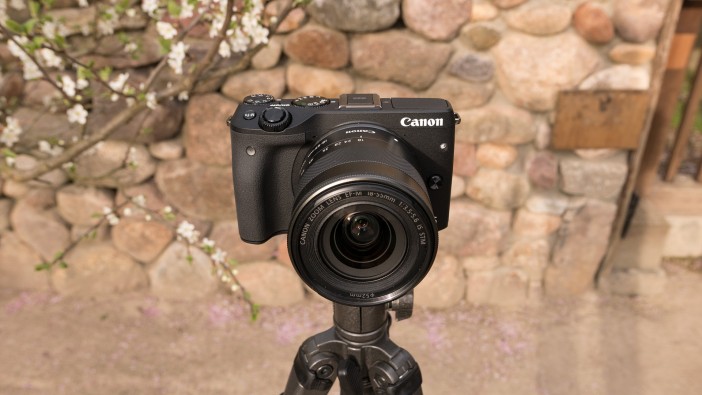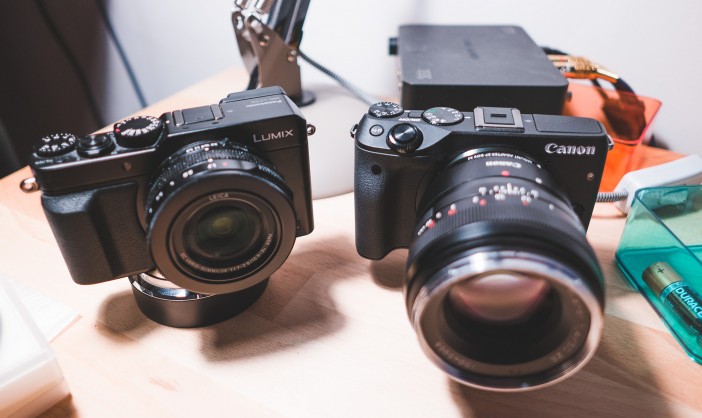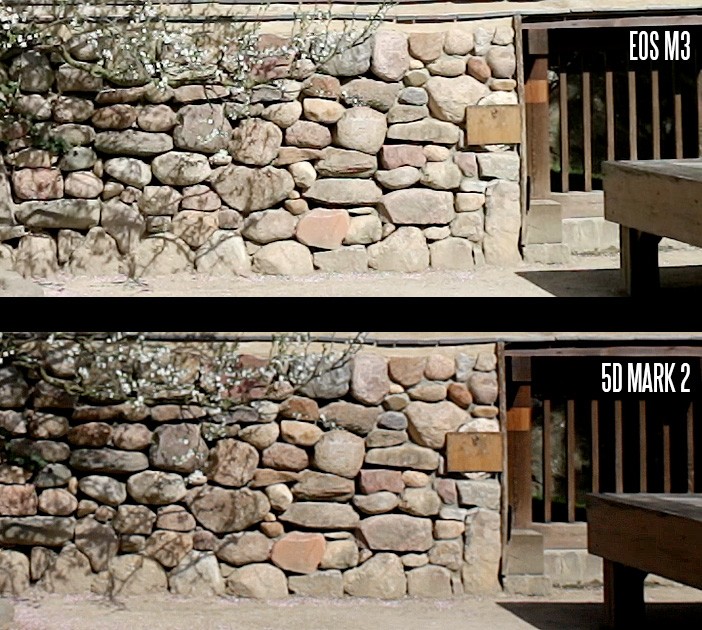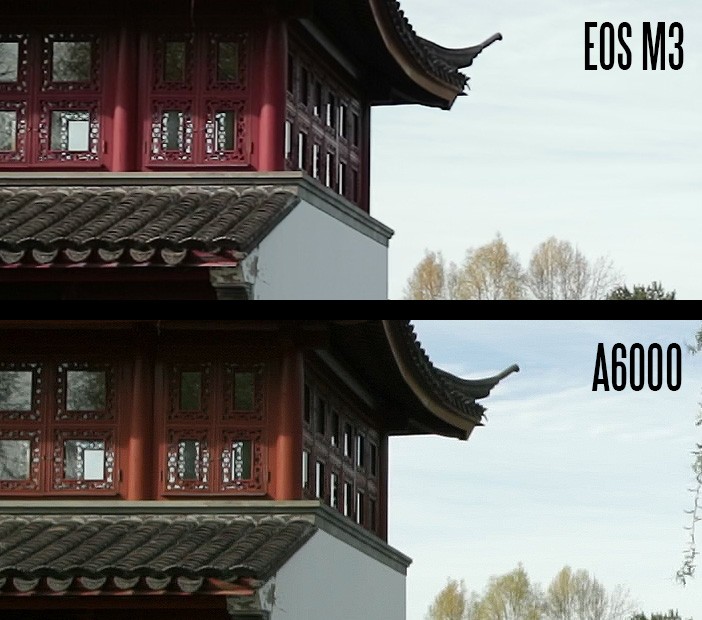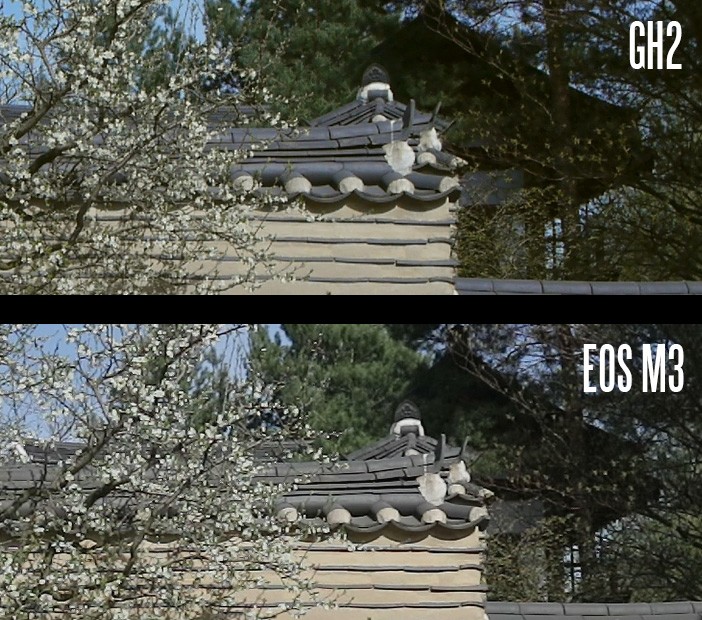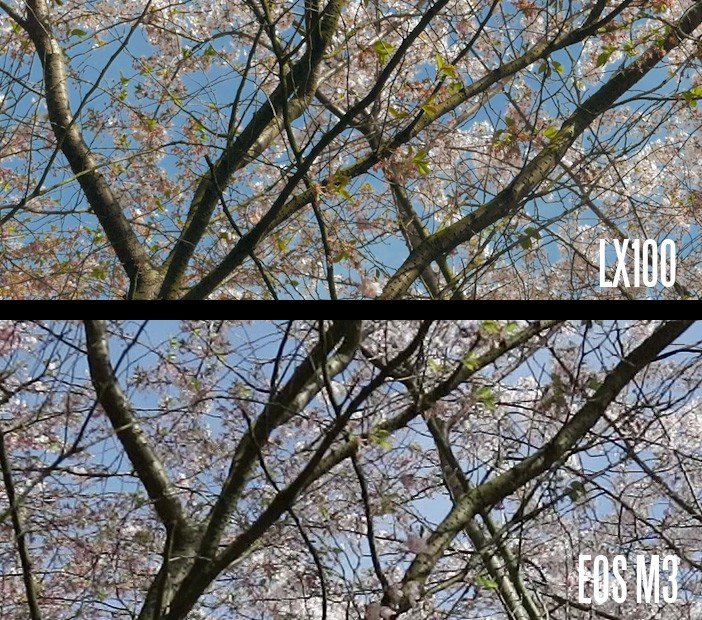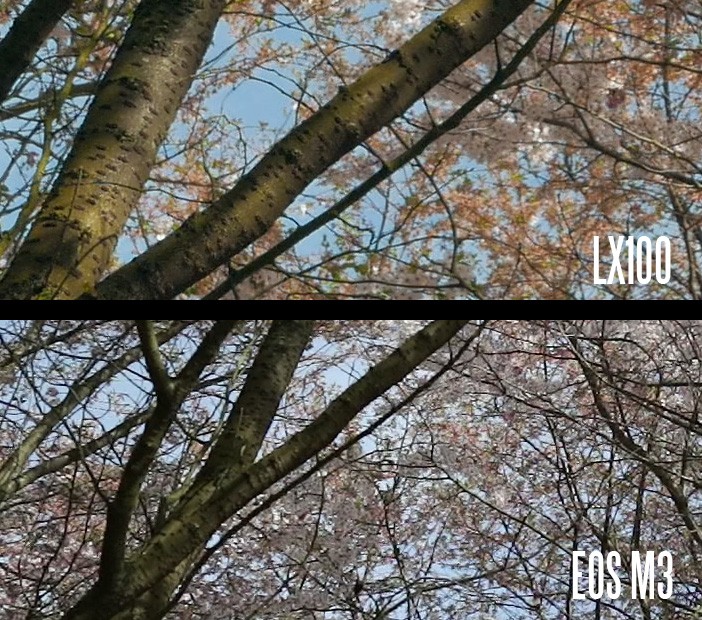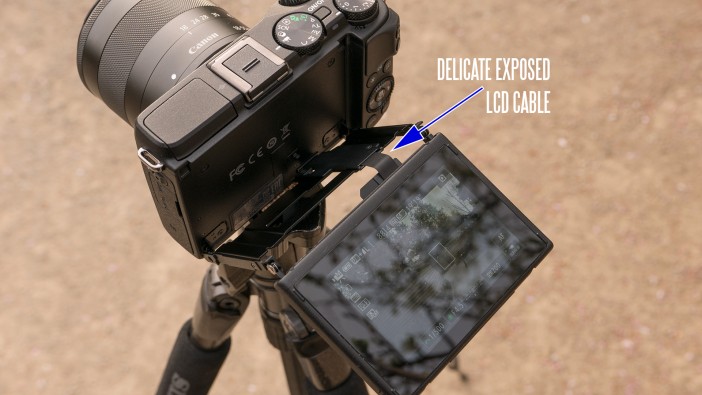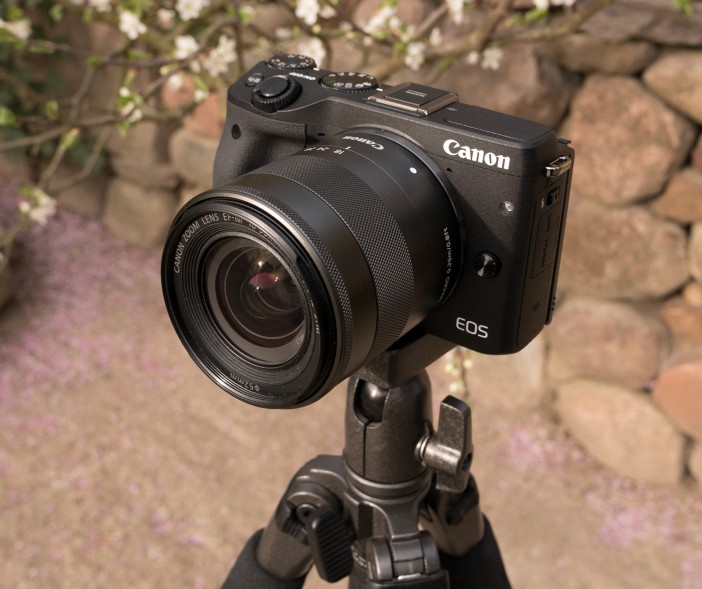[vimeo]http://vimeo.com/125560269[/vimeo]
Comment on the forumThe EOS M3 features Canon’s new flagship 24MP APS-C (Super 35mm) sensor, the flag bearer for future Canon APS-C DSLRs such as the 760D.
Now released in Europe and Asia but not in the US, does the M3 rage against the dying of the light or go quietly into the night?
First I would like to congratulate Canon. Video quality on the EOS M3 has finally caught up with the GH2 from 2011.
4 years later and with a staggering mirrorless lens range of four, the EOS M3 is truly a force to be reckoned with!
However I should dampen my enthusiasm just a touch as the EOS M3 doesn’t quite match the GH2. There’s plenty of moire and aliasing in video mode.
It’s 2015 and the Panasonic LX100 does 4K video for the same price (around $700 euro) in the same size and class of camera. It also has a built in EVF where the M3 does not. It’s a pricy add-on.
However despite the justified cynicism most people feel towards Canon right now, the EOS M3 is actually a lot of fun and a great stills camera and video quality is certainly an improvement from the 70D.
The AF system is interesting on this camera. Hybrid Pixel CMOS AF III (note: not as good as Dual Pixel CMOS AF on the 70D) does work well with the 18-55mm kit lens. With 22mm F2 though, or with EF and EF-S lenses via the official EOS M adapter, AF varies from dreadful (fails altogether with the Tamron 24-70mm F2.8 VC) to acceptably good (Canon 24mm F2.8 EF-S STM or EF 35mm F2.0 IS). So if you want to use your Canon lenses on a mirrorless body and get AF which is actually usable, the M3 gives you that. The Metabones adapter on a Sony does not.
With the 18-55mm kit zoom, the M3’s AF is very nice to use as a walk-around point & shoot for stills and video. Great for beginners. It’s really fast to shoot video with compared to manual focus. It reliably locks to your subject and doesn’t waver, hunt or pulse during a shot (in good light). The touch screen works well to select your subject quickly and begin recording. It’s very quick to lock focus simply by hitting the MF button before recording.
With moving subjects it isn’t reliable enough to replace a focus puller of course. But for locked down shots it’s a great aid to quickly establish focus without having to magnify to confirm manual focus, which is just as well as the focus zoom assist doesn’t work in movie mode! In stills mode it does but if you record movies in this mode even if the dial is set to M, movie exposure is automatic.
While recording with manual focus, if you change your mind and want to shift focus around usually you have to stop recording, magnify the screen or enable peaking. With the EOS M3 you simply touch the screen on what you want to focus on and it goes there in Servo AI mode. Great for consumers.
For manual focus the M3 has peaking! Yes peaking on a Canon stills camera!! Is that a first? This is one of the better implementations I’ve tried too, right up there with Blackmagic.
The upshot of having such solid AF in live-view as well as peaking for MF is this is a VERY easy camera for beginners to focus and for pros it is very quick to establish focus with.
Image quality
http://vimeo.com/125528323
I’m very happy with the stills from the new 24MP sensor. Video quality on the other hand is mediocre to say the least and would not even have been the best for the money 4 years ago.
This judgement of course depends on your benchmark. Even for 1080p viewing, quality is pathetic versus the Panasonic LX100’s 4K acquisition. On an Apple retina display or 4K TV the difference is even more noticeable between the two. However the EOS M3’s interchangeable lens mount helps it out when it comes to an atmospheric shallow depth of field & low light performance vs the fixed lens Micro Four Thirds LX100. Video quality on the M3 is broadly in the same ballpark as the Sony A6000 but isn’t as clean or as moire resistant as the Nikon D5200/5300 or D5500.
The good news is, the M3 is a significant improvement on the 70D and the 7D. Detail is just short of the ageing GH2 which was highly rated in its day for delivering crisp 1080p. The M3 however is sadly more prone to moire than the GH2 and it is likely the 750D and 760D will inherit the M3’s standard of video with the same sensors. I wouldn’t expect a miracle any time soon…for as long as Canon have nominated their Cinema EOS cameras for video quality.
Usually Canon’s APS-C sensors are 1.6x crop. I noticed when setting up my studio test scene for the 70D and EOS M3 that the field of view with the same lens – a Canon EF-S 24mm F2.8 STM – was slightly wider on the M3 compared to the 70D. Sony’s APS-C sensors are 1.5x crop. This begs the question – does the M3 feature a Sony sensor in a Canon body, like the 1″ Canon G7X?
The studio shootout heralded other surprises. The LX100 came out as a clear winner for resolution as you’d expect – but its dynamic range came out significantly better than the Sony A7S or Nikon D750 could manage in a rec.709 colour space on default settings. The Sony A7S and A7 II only pull out a dynamic range advantage over the LX100 when shooting S-LOG2 or raw stills. So if you don’t want to grade SLOG2, the LX100 offers a very good image.
So if you ignore the very large variable of lenses and sensor size, the LX100 tops the shootout, amazing considering this is essentially a $700 compact! The A7S comes in second followed very closely by the Nikon D750, whose flat picture profile merely needs a curve adjustment and nothing else in post, so much easier than handling S-LOG 2 unless you have pre-built LUTs for it. The A7 II trails, with worse aliasing and moire. The EOS M3 sits slightly ahead of the A7 II for detail. The 70D and 7D come firmly last with heavy false colour, moire, aliasing, weak colour and very poor detail for 1080p. The LX100’s only weakness was it’s low light performance… even at ISO 400 there’s a fine noise over the shadows.
It’s worth noting that even with sharpness turned all the way down on the EOS M3 picture profile (Faithful) video has noticeable signs of digital sharpening being applied in camera. The A6000 could dial down softer.
Now for some 1:1 crops of 1080p. Curiously, the oldest Canon model for video, the 5D Mark II is able to resolve the same amount of detail as EOS M3 but more smoothy when equipped with the VAF-5D2 anti-aliasing filter (and in H.264), let alone when shooting raw video with Magic Lantern where it far exceeds the quality of the EOS M3. Not bad for a 6 year old camera and it shows how little progress Canon have made in all this time.
As you can see below, the A6000 most closely resembles the EOS M3 for video quality. Does it have the same 24MP CMOS from Sony?
The GH2 offers a good level of detail in 1080p but is starting to look dated by modern standards. The EOS M3 offers similar detail, but there’s moire & aliasing isn’t as well controlled lending a ‘scratchy’ texture to fine detail.
The 4K of the Panasonic LX100 soundly thrashes the EOS M3 and offers perfect 1080p with a wider dynamic range and better colour. The extra detail brings out far more red and green in the shot of the cherry blossom tree below. This camera also looks far more pleasing on an Apple retina display or any computer display at close viewing distances for that matter so is the better choice for Vimeo and YouTube.
The LX100’s price and size makes it cheaper AND smaller than the EOS M3 which makes it all the more amazing that the LX100 has a far brighter F1.7-F2.8 zoom lens, built in EVF and 4K video.
This 1:1 crop is taken from my edit after the LX100’s 4K has been down sampled to 1080p –
But here’s the real difference at 1:1 with the LX100’s 4K and the same sized crop from the EOS M3’s 1080p at 1:1. The Canon video looks like it came from a fax machine.
Subjectively the quality of video on the EOS M3 depends a lot on your shot focal length and focus distance. Close-ups work better as do macro and telephoto shots. Shots with background separation and a shallow DOF also look ok so get those fast aperture primes out! Wide angle shots or subjects at infinity focus look poor. Subjects that command fine, sharp detail look scratchy and digital on the EOS M3. Subjects that are softer or closer to the lens look much better. Faces look ok. The prime example in the video I shot above, is that coins under the water at the start – they look fine as do the flowers up-close – but as soon as the focus tracks to the finely detailed background further way you really notice the drop.
Even if you don’t care for 4K and are fine shooting 1080p the M3’s video quality is definitely a league below the Sony A7S, Panasonic GH4, LX100 and Samsung NX1. That said, on the GH4, LX100 and NX1 you will need to acquire your footage in 4K and downsample to 1080p in post (this is trivial to do) as their internal 1080p modes are nothing to write home about. The A7S has the best internal H.264 1080p of any stills camera right now.
Despite my clear misgivings as a pro, indeed an enthusiast, for the most part I feel most M3 users will be satisfied-ish with video quality. The target market of this camera isn’t as demanding as we are and neither are their audiences on Facebook. It’s an easy camera to get nice results with quickly. File sizes are small and the output on the camera’s screen or when connected to a family TV and viewed at a reasonably far viewing distance looks better than on a computer display.
Stabilisation
With EOS-M lenses that feature optical IS like the 18-55mm, the M3 has two modes of stabilisation, both very effective but one involves a field of view crop. Mode 1 is the steadiest and best for walking, but this crops FOV and magnifies any flaws in the image like aliasing. Mode 2 is a bit less effective, but as it only utilises optical IS so there’s no field of view crop from the digital stabilisation (and you can apply this in post with Adobe’s Warp Stabiliser anyway). IS works with Canon EF lenses too via the Canon adapter but rather than a menu option for IS you use the lens-switch to toggle it on or off and there’s no “Mode 1” for enhanced digital + optical stabilisation.
Here’s my demonstration of IS on the M3 (note the crop in Mode 1 compared to Mode 2 or Off). In mode 1 the system is almost as effective as the 5 axis IBIS on the Olympus E-M1 – but not with any lens, only the limited EOS-M range with IS (the 22mm F2.0 doesn’t have it).
http://vimeo.com/125530770
Ergonomics
Outwardly the EOS M3 drops the more playful look of the predecessors and does look more serious, but not in the way a Fuji X-T1 is. Rather, it looks like your boss’s bland holiday camera.
However I really like the ergonomics of the EOS M3. It’s simple without being too dumbed down. It has just enough physical control to pass the grade as an enthusiast mirrorless camera. As a stills camera, it does compliment a larger full frame Canon DSLR by being smaller, cheaper, lighter – yet compatible with the same lenses. It’s not pocketable with a zoom like the Panasonic LX100 but with Canon full frame primes like the 35mm F2.0 IS EF the M3 makes for a small-by-DSLR standards 70D-a-like. What’s not to like about that?
Suppose like me you have a big expensive DSLR like the 1D C or 1D X. You keep it aside for serious work and the M3 gives you the ability to bring it along on trips or for more casual shoots. OK video quality would be far better on an LX100 or GH4 – but for stills the M3 is perhaps the better choice because of the AF with modern Canon lenses and the larger, higher resolution sensor. The Sony A6000 is a match for stills quality but more fiddly ergonomically and lacking that decent AF with Canon lenses via the adapter. It does however have a built in EVF, something which has been standard on non-Canon mirrorless cameras for years.
The M3 has an articulated screen which is very welcome indeed, but the exposed ribbon cable for the LCD is not; very delicate and easy to snag
Conclusion
I don’t think Canon see mirrorless as a serious alternative, even to their low-end DSLRs. Canon know that mirrorless sales haven’t made significant inroads into the billion-dollar DSLR market. Instead a different future-facing technology has. The smartphone.
I don’t think Canon see stills cameras as a viable alternative to video cameras either. Once you forget the enjoyable hassle-free handling and excellent stills quality, video quality on the M3 is a bad joke compared to some of the competition. The tiny Panasonic LX100 is in a different league, with 4K even when down sampled to 1080p looking far more detailed with a much wider dynamic range and better colour.
Where does that leave the M3 and its place in the world? Isn’t it a bit pointless? Not entirely. The EOS M3 feels uninspired but I actually quite like it. It banishes the AF woes of the EOS M1 and improves video quality over the 70D while offering the next generation of Hybrid Pixel CMOS AF II. As a consumer point & shoot it gets the job done and is fun to use for both video and stills as long as you don’t expect much from the 1080p quality itself. I think it’s a solid platform for Canon to develop their mirrorless technologies and mirrorless lenses while taking a few sales off Sony. It competes most closely with the A6000 although Canon chose not to put some of the Sony’s features in this camera such as 1080/60p or a built in EVF. That comes across as a rather cynical cost cutting measure.
Should you get it? Video enthusiasts looking for outright image quality – NO. Steer well clear. If you want something small get the LX100. If you want something with interchangeable lenses get the A7S and a Metabones EF adapter, the GH4 or the NX1. As a stills camera though the M3 appeals more broadly. Canon 70D, 700D or 100D users who never use the optical viewfinder and don’t need the faster AF via the viewfinder might prefer the M3. It offers similarly robust AF in live-view as the 70D but with much shorter live-view blank-out times between shots. The high quality articulated touchscreen is like having semi-manual focus without the hassle of zooming to confirm a sharp image. If you use a lot of legacy glass then the mirrorless mount and peaking will come in handy as well. Other Canons need Magic Lantern for that.
Video on the M3 looks best when using a longer focal length or focussing closely your subject, rather than going for wide angle shots of landscapes. Moire and aliasing is a problem with certain subjects such as the rippling surface of a lake or fine patterns shot from a distance. Stabilisation is a plus point though, it’s very effective with the 18-55mm OIS kit lens in mode 1 (digital + optical IS). This is an easy camera for beginners to get a shot in focus and steady. Also for those looking for solid AF in video mode, the EOS-M3 is pretty good in that department versus other mirrorless cameras.
Bottom line – the M3 is a fun stills camera which does ‘OK’ video for consumers, like a GH2 but with moire! The thing is, it’s certainly no worse than the Sony A6000 in 1080/24p and that customer is the real target of the M3, not filmmakers. It belongs to the Canon eco-system which is an advantage over Sony and I enjoyed Hybrid Pixel AF III for stills and for video – I find it great fun to use, even with some of my non-STM lenses like the EF 35mm F2.0 IS. The sensor is APS-C of course, larger than Micro Four Thirds for stills and certainly higher resolution. Will I be keeping the M3? I really don’t know. I suppose when I don’t want to risk my more expensive kit like the 1D C or just want a smaller Canon body to have some fun with, mainly for stills, then the M3 fits the bill.
I just can’t shake my disappointment about Canon’s offerings for enthusiasts looking for quality video though. Do they really expect us to upgrade from a sub $1000 70D or EOS M3 to a $5500 Cinema EOS C100 Mark II if we want better video? Do Canon really think Mr Pixel Peeper is going to be satisfied with mushy 1080p and moire and aliasing when Panasonic offers 4K for $750? You have to assume they don’t care about enthusiast video shooters at all. And that’s a shame.
Pros
- Easy for beginners to shoot video without having to worry too much about focus or stabilisation
- Good stills quality for the price
- Hybrid Pixel CMOS AF III useful in movie mode for quickly confirming focus before locking with single press of the MF button
- Very good peaking for manual focus
- AF has little to no hunting in good light with 18-55mm kit lens
- High quality touch screen effective for quick focus racks during a shot
- Good display visibility in daylight
- Good ergonomics
- Effective IS for both stills and video
- Reasonably fast AF for stills with EF-M STM lenses
Cons
- Moire and aliasing
- Uninspired video quality
- Extremely weak EF-M lens range
- No built in EVF
- 60p limited to 720p and no higher frame rates
- Delicate LCD ribbon cable heavily exposed by tilting mechanism
- Weak battery life
- Hybrid Pixel CMOS AF III performs poorly with most EF lenses via official Canon adapter
- Somewhat charmless design
- Panasonic LX100 offers much better value for money not to mention 4K video and fast Leica lens
- Video record button and playback button require heavy presses to activate
- No US release
- 18-55mm F3.5-F5.6 is a bit soft
- Magnification assist for MF doesn’t work in movie mode
- Movie recording in M manual stills mode ignores exposure settings and goes full-auto
- Canon are starting to p*** me off in general, as a brand
- Doesn’t make tea without shimmering moire contamination on surface




